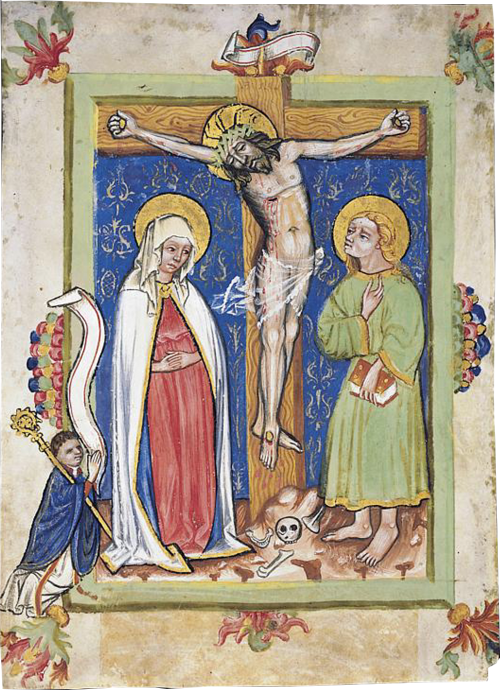


Bamberg (?) Painter
, c. 1440-1450Bamberg (?) Painter
Description
This impressive full-page miniature, blank on the verso, must have prefaced the Canon of the Mass in a Missal. It was commissioned by an unidentified bishop or abbot who is depicted kneeling on the left with a crozier and a blank banderole, crossing the picture frame.
Christ hangs on a massive wooden cross, its grain fully articulated, and a blank banderole rising from the top mingles with the acanthus border decoration. The style of the painting reveals the impact of Bohemian art on southeastern Germany, Bavaria, and Austria in the first half of the fifteenth century. Features of the “Weiche Stil” (Soft Style) that characterize this illumination include the sfumato modeling of the face of Christ, the transparent drapery of his loincloth, and the sweetness of Mary’s expression. This delicate sensibility, for example in the treatment of the figures, is fused with a powerful expressionism evident in the face and gesture of John and especially the musculature of the tortured body of Christ, all set in an austere landscape. On the barren ground appear the cross and skull bones, references to the sin of Adam. A palette of rose-pink, light green, and blue also derives from Bohemian art earlier in the century.
Unusual is the border decoration of green, pink, and gold acanthus that springs from the corners and is clustered at the sides of the illusionistic frame. These decorative details and the pictorial elements described above recall Bohemian painting in the orbit of the artists responsible for the Wenceslas Bible around 1390 to 1400 (Vienna, ÖNB, Cod. 2759-64). Bohemian-inspired elements continue to appear in illuminations from southeastern Germany and Austria around 1450, including the light green frame and modeled figures in a Missal illuminated in Vienna for Matthias Corvinus in 1469 (Rome, BAV, MS Ross. 1164) and a full-page Crucifixion miniature by an anonymous Nuremberg illuminator around 1452 (Nuremberg, Stadtbibliothek, MS Cent. III, 86; see Grebe 2008, abb. 3, p. 14). Further comparison can be made to a hand-colored Missal printed on parchment in 1496 by Johann Pfeyl in Bamberg (Free Library of Philadelphia, Lewis E M 44:24A, second edition of the 1490 Missale Bambergense printed by Johann Sensenschmidt and Heirich Petzensteiner).
The parchment leaf with isolated losses of pigment and some discoloration at the edges, including a rectangular section at the lower edge, possibly remnants of a former label, in good condition.
Literature:
Unpublished; for comparisons see:
A. Grebe, “’Er illuminiret ihnen schöne Bücher und machet ihnen ihre Wappen und Kleinot in ihre Wappenbrief:’ Nürnberger Buchmalerei von der Dürerzeit bis zum Barock,” in A. Grebe and T. Eser, Heilige und Hasen: Bücherschätze der Dürerzeit, Nuremberg, 2008, pp. 11-30.
J. Frings and J. Gerchow, Krone und Schleier: Kunst aus mittelalterlichen Frauenklöstern, Munich, 2005 [exhibition catalogue].